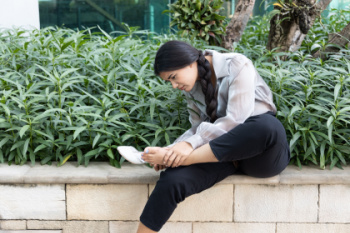
Blisters on the feet usually form when friction or pressure damages the outer layer of skin, causing fluid to build up as a natural protective response. This often happens from shoes that rub, or repetitive movements, such as walking or running long distances. Moisture, heat, and socks that do not allow airflow can make skin more prone to blistering. Other causes include burns, frostbite, allergic reactions, and certain medical conditions like eczema or diabetic neuropathy. Blood blisters may appear when the skin is pinched or crushed, leading to bleeding beneath the surface. Blisters can be painful, especially on weight-bearing areas of the foot, and may limit mobility. It is important not to pop a blister, as breaking the skin can increase the risk of infection. If a blister becomes discolored, swollen, or does not heal, medical attention may be needed. If you frequently develop blisters on your feet, it is suggested that you schedule an appointment with a podiatrist to determine the cause and receive safe and sterile treatment.
Blisters may appear as a single bubble or in a cluster. They can cause a lot of pain and may be filled with pus, blood, or watery serum. If your feet are hurting, contact Daniel Bell, DPM of Florida. Our doctor can provide the care you need to keep you pain-free and on your feet.
Foot Blisters
Foot blisters are often the result of friction. This happens due to the constant rubbing from shoes, which can lead to pain.
What Are Foot Blisters?
A foot blister is a small fluid-filled pocket that forms on the upper-most layer of the skin. Blisters are filled with clear fluid and can lead to blood drainage or pus if the area becomes infected.
Symptoms
(Blister symptoms may vary depending on what is causing them)
- Bubble of skin filled with fluid
- Redness
- Moderate to severe pain
- Itching
Prevention & Treatment
In order to prevent blisters, you should be sure to wear comfortable shoes with socks that cushion your feet and absorb sweat. Breaking a blister open may increase your chances of developing an infection. However, if your blister breaks, you should wash the area with soap and water immediately and then apply a bandage to the affected area. If your blisters cause severe pain it is important that you call your podiatrist right away.
If you have any questions, please feel free to contact our office located in Pembroke Pines and Plantation, FL . We offer the newest diagnostic and treatment technologies for all your foot care needs.
